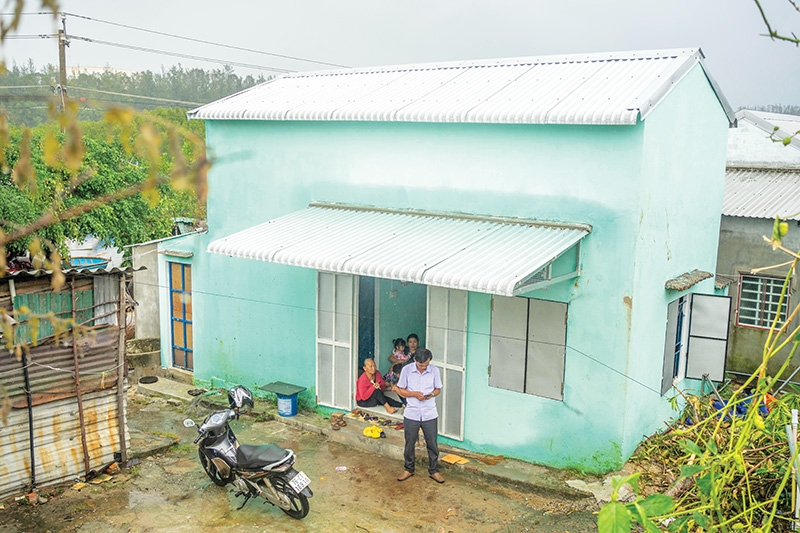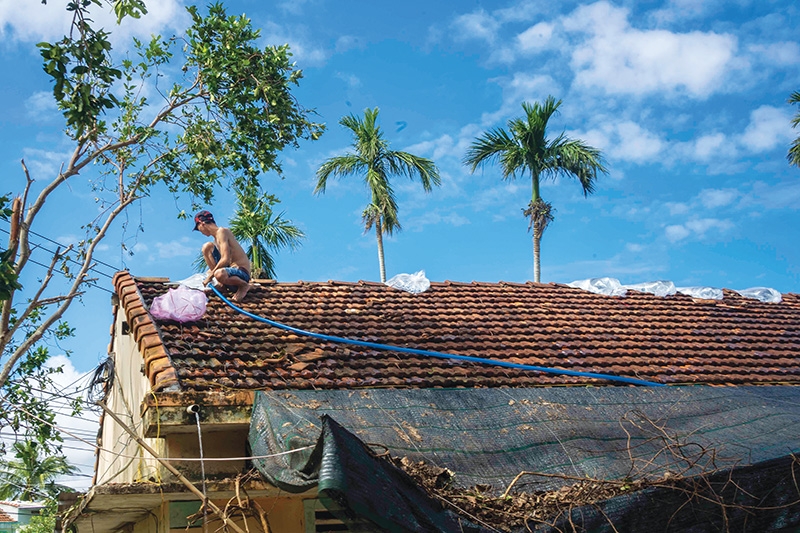Flood-proof homes saving the day for central coast families
 |
| Storm- and flood-resilient homes could be rolled out to even more at-risk provinces |
One month has elapsed since storms and floods swept across the coastal district of Quang Ninh in the central province of Quang Binh, where there are thousands of poor households. Today, many of them like Nguyen Thi Linh’s in Hien Ninh commune have been unable to rebuild their homes torn down by the disaster.
Linh, a 65-year-old disabled farmer, lives in Bac Co Hien hamlet and depends on support from relatives and neighbours. Her husband passed away many years ago.
“The terrible flood has swept away homes in a wink. Many have become homeless and penniless,” Linh said. “Our house was heavily damaged, and I don’t have money to repair it. I’m living temporarily at a relative’s home.”
Along with Bac Co Hien hamlet, many others in the district have faced the same fate in the wake of the disaster.
Le Thi Nho, 80, from nearby Nam Co Hien hamlet in Hien Ninh, said that her house and assets had been swept away by the flooding. “We have nothing now,” said the woman in sorrow. “So do the villagers. Many of them have become homeless.”
Le Hoai Vu, Deputy Chairman of Hien Ninh commune, told VIR that many households like Linh’s and Nho’s have been facing the same plight. “Many have been evacuated to higher locations to avoid the flooding. Their shabby houses have been heavily damaged.”
The commune has a population of over 8,000 people living on 270 hectares of agricultural land, with an average per capita income of VND20 million ($870) per year.
 |
| Increasing disasters have seen homes more susceptible to damage |
Towering losses
According to the Ministry of Agriculture and Rural Development (MARD), the natural disasters have become increasingly fiercer. “Never has the central region faced such horrific storms and floods, with 249 deaths, 57 missing, over 1,500 houses smashed down, and another nearly 240,000 seriously damaged,” said Deputy Minister of Agriculture and Rural Development Nguyen Hoang Hiep.
Moreover, agriculture was also seriously affected, with the damage and losses of 4,000 hectares of rice, 7,600ha of different crops, and 12.670ha of fishery farms, besides the death of 38,500 cattle, 3.2 million poultry, and the damage of 165km of sea dykes and estuaries, 50km of embankments, and 88 depression spots with a total length of 141km.
“The total financial loss is estimated to be about VND30 trillion ($1.3 billion). However, this statistic remains insufficient. The storms and floods will continue to leave a long-term aftermath that cannot be calculated with just figures. So many people have lost their livelihoods and had to leave their home lands for other locations to live,” Hiep said. “I think it may take over 10 years for many to resume their normal lives.”
In an attempt to help many in the face of increasing disasters, the MARD and the Ministry of Construction (MoC) have been implementing an initiative to construct over 4,000 storm- and flood-resilient houses since 2017 in the five coastal central provinces of Thanh Hoa, Quang Binh, Thua Thien-Hue, Quang Ngai, and Quang Nam.
The initiative is part of a nearly $42 million project to improve the resilience of coastal communities to climate change in Vietnam, funded jointly by the Green Climate Fund (GCF), the Vietnamese government, and the United Nations Development Programme (UNDP). The capital includes over $30.8 million in grants from the GCF and $1.6 million from the UNDP, while the remaining comes from the Vietnamese government.
“This is quite a helpful and practical housing initiative. It has helped provide storm- and flood-affected people with safe homes,” Nguyen Manh Khoi, deputy director of the MoC’s Housing and Real Estate Market Development Department, told VIR. Khoi is also director of the GCF Management Unit for the component of constructing such homes. “Beneficiaries have been able to protect their assets. The houses are their big dreams.”
So far about 3,200 houses of this type have been built in the five provinces, with 426 built in Quang Nam.
Under this project, the 4,000 new houses will benefit 20,000 poor and highly disaster-exposed people over 100 communes of the five coastal provinces.
These houses are based on simple designs to create a stronger structure. Features include a mezzanine level for flooding protection, reinforced roofing, and the use of strong cement.
The mezzanine level allows residents to comfortably stay in their houses during a disaster, safe from high flood levels. This level can also be used as an area to store valuables during disasters and avoid it being washed away or spoiled by flooding waters.
Each house is funded from about $1,700 from the project, and another $600-800 from a government programme under 2014’s Decision No.48/2014/QD-TTg on assistance in constructing storm- and flood-resilient homes for poor households in the central region. If the household wants to install additional parts or expand the houses, they mobilise their own financial resources.
Wider hopes
Khoi of the MoC said that the initiative should be expanded in terms of beneficiaries and localities.
“It has turned the dreams of thousands of people into reality. They have felt safer during storms and flooding. Many of their neighbours, who have strong houses but were flooded due to low locations, even came to their houses for temporary dwelling,” Khoi said.
The project aims to support vulnerable households, especially poor ones and those consisting of single mothers, in the five central provinces.
“However, we expect that the initiative will be implemented in all 28 coastal provinces and cities nationwide, meaning there more houses and more beneficiaries,” Khoi said.
As for poor people Nguyen Thi Linh and Le Thi Nho, they wish to be supported with new houses. “We need a safer home,” Linh said. “It will give us a good sleep. We need to have a stable life.”
Vu of Hien Ninh said that currently under the initiative, 37 storm- and flood-resilient houses have been built so far. “The commune needs a total of about 500 houses of the type. Many poor households are in misery as their houses have been heavily damaged.”
In another case, 50-year-old Nguyen Ngoc Thinh in Cam An commune, situated in Hoi An town district of the central province of Quang Nam, told VIR that his dilapidated house cum shop at Cua Dai beach slipped into the sea due to serious depressions in the location.
“We need money to build a new house, but we can’t afford it,” said Thinh, who has become jobless now.
At present, a study is being formulated with a plan to apply the initiative in all of these 28 localities. If it becomes feasible, the designs of houses will have to be changed because the houses will be located from north to south in the country, while the existing design is only applicable to houses in the central region.
According to a recent study by the UNDP and the MoC, there is a large need of support to build around 110,000 resilient houses in 28 coastal localities, of which nearly 25,000 are of urgent need to protect people and their properties. It is important to replicate and scale up resilient housing models in Vietnam, especially for the poor and near-poor in these localities. This requires concerted efforts by the government, the private sector, individuals, and development partners.
“We believe that the more of these resilient homes are built, the less people will suffer from loss and damages, and with safe homes and protected property the less people will need emergency support in the future. We would like to invite all partners to join with us to build more storm-resilient houses to ensure that no-one is left behind,” said Caitlin Wiesen, UNDP resident representative in Vietnam.
What the stars mean:
★ Poor ★ ★ Promising ★★★ Good ★★★★ Very good ★★★★★ Exceptional
Related Contents
Latest News
More News
- Protect what’s next: towards a future free from meningococcal group B disease (December 05, 2025 | 18:00)
- New ILO report offers policy recommendations for disability inclusion (December 04, 2025 | 15:18)
- Maternal job loss may affect children’s mental health, research shows (December 03, 2025 | 19:11)
- Women lead Vietnam’s shift to climate-resilient agriculture (December 03, 2025 | 19:10)
- Experts highlight unpaid care work as key barrier to gender equality (December 03, 2025 | 15:15)
- Opportunities and inequalities for women workers in Vietnam's garment industry (December 03, 2025 | 09:00)
- Vietjet flights carry love to devastated central region (November 28, 2025 | 11:35)
- New initiative to boost the fight against domestic violence (November 26, 2025 | 10:00)
- South Korea funds IOM relief for Vietnam’s typhoon-affected communities (November 24, 2025 | 15:33)
- AI and human-centred values set to shape the future of HR in Vietnam (November 21, 2025 | 18:04)

 Tag:
Tag:




















 Mobile Version
Mobile Version